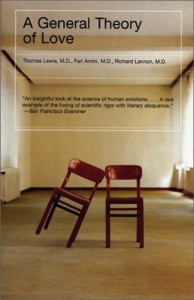 CLICK to BUY “Don’t Try This Alone”
CLICK to BUY “Don’t Try This Alone”
“A General Theory of Love,” after Einstein’s “General Theory of Relativity,” is by Thomas Lewis, Fari Amini, and Richard Lannon, three MDs and professors of psychiatry. They’re men on a mission to break the truth about the brain to America. It was passed to me with the promo that it has the latest science on how to re-program painful mental patterns like a broken heart. [FN1]
Emotions, they report, are imprinted in the infant brain via what they call “limbic resonance” and create how and whom we love, which creates who we are. See Part 2: Limbic Resonance.
I never meant to get into brain science. But once I read “General Theory of Love” or GTL as we dubbed it, I saw that what I didn’t know was killing me. It became obvious that I had brain trauma from infancy and I was walking around mis-attuned to people from deep in my brain stem.
GTL also demonstrated that no matter how much “lonely pain” I had after my divorce, romance was only getting me into deeper kimche because my mis-attuned brain kept “finding” mis-attuned men. It showed why my men couldn’t relate; it also showed that I couldn’t, either.
The doctors conclude (no surprise) that truly good, attuned therapy is the only way to get our brains re-tuned — at the expense of five to ten years’ time and the price of a college education.
But I’d just been through therapy — it only made me feel much worse. They explain that, too: most therapists are poorly attuned to their clients! One must take pains to locate the select few who can manage. In fact, GTL is a wake-up call by three top shrinks to alert the public that therapy is failing us.
Now we have: my brain is fried; romance only creates more pain; most therapists are clueless; and every time I see my best friend, I have to look at what a suicide in the family does to survivors. I faced No Exit from the emotional pain.
That left me two choices: become a nun or research the brain. I sang and listened to Schubert’s song “The Young Nun” quite a bit to test-drive the impulse, but my body wasn’t buying it. On to brain science.
War on Emotions
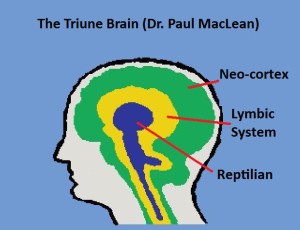 GTL starts with a bang: American society has declared war on emotions and that’s a tragedy, they state, because emotions, led by love, are what allow mammals to survive, humans included.
GTL starts with a bang: American society has declared war on emotions and that’s a tragedy, they state, because emotions, led by love, are what allow mammals to survive, humans included.
“Traditional versions of the mind hold that Passion is a troublesome remnant from humanity’s savage past, and the intellectual subjugation of emotion is civilization’s triumph,” says the Preface. But the last ten years’ brain science discoveries show instead that “the brain’s ancient emotional architecture…is nothing less than the key to our lives.”
“Modern America plows emotions under, a costly practice that obstructs happiness and misleads people about the nature and significance of their lives. That… is more damaging than one might suppose” they write. “Science has discovered emotionality’s deeper purpose: emotions allow two human beings to receive the contents of each others minds…
“Emotions have a biological function — they do something for an animal that helps it to live.”
The authors show the importance of emotions with the “triune brain” model, posited by neuroscientist Paul D. MacLean, MD in the 1960s and proven by subsequent brain scan techniques. Mammals have three distinct brain regions with different physiologies and functions almost as different as those of the lungs and kidneys. Even the neurons in each region are different. [FN2]
Take the three in archeological order of appearance. At the top of the spinal chord sits the reptilian brain stem. It provides raw survival instincts, basic functions such as breathing, heart rate, body temperature, and digestion, and also appears in the most primitive reptiles.
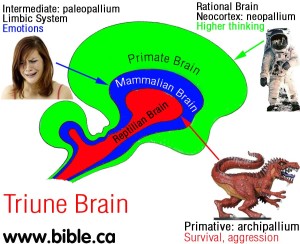 Next, mammals uniquely have developed the limbic brain, which provides emotions, something entirely new with the advent of mammals; it wraps around the brain stem. It allows mammals to carry and care for their young (rather than hatch and eat them as do reptiles). (I’m not familiar with www.bible.ca but they do a great cartoon.)
Next, mammals uniquely have developed the limbic brain, which provides emotions, something entirely new with the advent of mammals; it wraps around the brain stem. It allows mammals to carry and care for their young (rather than hatch and eat them as do reptiles). (I’m not familiar with www.bible.ca but they do a great cartoon.)
For this the limbic brain gives rise to love, nurturing, joy, etc., which release “feel good” opiates into the bloodstream so we do more of that. It also provides hatred, fear, anger, etc., which release “feel bad” stress chemicals, so we know when we’re being hurt instead of loved. Hopefully.
Wrapped around all that is the third and late-comer frontal cortex, best developed in primates, which allows thought, language, future planning, willpower etc. During development, every mammalian fetus recapitulates this three-lobe brain phylogeny.
“A body animated only by the reptilian brain stem is no more human than a severed toe. Reptiles don’t have an emotional life,” GTL notes. “The advent of the mammalian limbic lobe, uniquely, allows mammals to care for their own, have emotions, and risk and lose life for another.”
“Emotions are good? I can’t think them away? These societal voices in my head telling me to ‘just stuff it and grow up’ are wrong and maybe damaging? That’s a relief,” I thought. “But I’ve sure got a lot of ’em and they’re a mess; now what?”
Stovepiped Brain
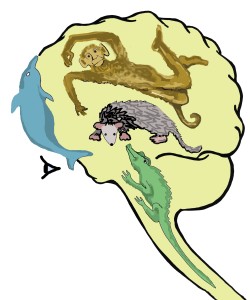 There’s the rub. Unfortunately, this “Lizard-Squirrel-Monkey Medley” is “stove-piped together” to optimize our survival long enough to reproduce, but “can often make for lousy quality of life,” as Dr. Ron Siegel puts it. Our brain is “fragmented, in-harmonious, and to some degree composed of players with competing interests” agrees GTL. [FN3]
There’s the rub. Unfortunately, this “Lizard-Squirrel-Monkey Medley” is “stove-piped together” to optimize our survival long enough to reproduce, but “can often make for lousy quality of life,” as Dr. Ron Siegel puts it. Our brain is “fragmented, in-harmonious, and to some degree composed of players with competing interests” agrees GTL. [FN3]
The limbic brain “hasn’t changed much in size or function from primitive mammals to man, and is pre-historic relative to the frontal cortex,” GTL continues. All three lobes “interdigitate like… like dusk and dawn,” but light and dark are not the same. “The cleavage between reason and passion is an ancient theme but no anachronism; it has endured because it speaks to the deep human experience of a divided mind.”
The frontal cortex only imagines that the other two take orders and obey logic. “Not so” says GTL. “Words, good ideas, and logic mean nothing to at least two brains out of three. Much of one’s mind does not take orders.” In reality the lower two lobes regulate the thinking cortex “unseen, unbidden, and largely uncontrolled…
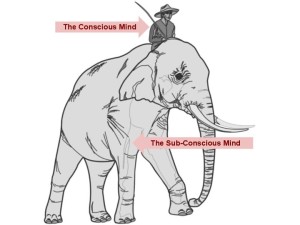 ”We say ‘I will’ and ‘I will not,’,” they quote novelist Gene Wolfe, “and imagine ourselves our own masters, when the truth is our true masters are sleeping. When one wakes within us, we are ridden like beasts.’ ”
”We say ‘I will’ and ‘I will not,’,” they quote novelist Gene Wolfe, “and imagine ourselves our own masters, when the truth is our true masters are sleeping. When one wakes within us, we are ridden like beasts.’ ”
Cripes, my heart won’t obey my head because it lives in a different country! “Frontal” (head) can’t tell Limbus (heart) to “just shape up” because Limbus doesn’t speak Frontal. My thinking cortex tells me not to run out into the street for my next romance and get hit by a truck, but my emotions ride me like a beast. So it’s baked into my physiology to keep running out into the street to be hit and eaten by reptiles in trucks. I’m really screwed.
Moreover, we need love to live and without love, we die, GTL continues. Here my anxiety went through the roof. I sure did feel like I was going to die without love, and soon; that was the whole nature of my roiling emotional pain. But I’m not finding any cozy mammals; I keep meeting reptiles who treat me like prey, so my doctors tell me to stay on Isolation Row.
How am I going to survive out here alone in the wilds without love?
————————-
Kathy’s news blogs expand on her book “DON’T TRY THIS AT HOME: The Silent Epidemic of Attachment Disorder — How I accidentally regressed myself back to infancy and healed it all.” Watch for the continuing series each Friday, as she explores her journey of recovery by learning the hard way about Attachment Disorder in adults, adult Attachment Theory, and the Adult Attachment Interview.
Footnotes
FN1 Lewis, Thomas, MD; Amini, Fari, MD; Lannon, Richard, MD; “A General Theory of Love”, Random House, New York, 2000. See Dr. Lannon interviews at: www.paulagordon.com/shows/lannon/
Preface excerpts at: www.nytimes.com/books/first/l/lewis-love.html
On therapy: www.goodreads.com/author/quotes/1503539.Thomas_Lewis
FN2 MacLean, Paul, MD, The Triune Brain in Evolution: Role in Paleocerebral Functions, Springer, 1990, 704 pgs. MacLean formulated his model in the 1960s as the head of the section on the limbic system at the Laboratory of Neurophysiology, National Institute of Mental Health (NIMH).
FN3 Siegel, Ronald D., PhD, “The Neurobiology of Mindfulness,” NICABM, April 15, 2011, available at http://www.nicabm.com/mindfulness-2011-new/ reports:
“Basically our brain evolved over a series of evolutionary accidents.
We have what’s often called the reptilian brain, which is the brain stem and disassociated structures. You could think of that as the “lizard brain.”
Then, on top of that is the mammalian brain, which involves our limbic system, all of our different emotional response systems, which we actually share with most of the other mammals, and of which a principle feature is our fight-or-flight system that responds to danger.
Then, we have the primate, or monkey brain that’s sitting on top of that. Here are all the higher cortical structures, so heavily developed in humans compared to the other animals, which allow for judgment, thought, and prediction.
So, this combination is sometimes called the Lizard Squirrel Monkey Brain Medley, and that’s what we have inherited.
And these different structures don’t always work so well together.
As we know, how many of us haven’t experienced ourselves at three in the morning suddenly awake because some combinations of these three brains are terribly activated, worrying about something, with lots of psycho-physiological arousal, when there’s actually nothing at all we can do about it. There’s no adaptive purpose to it, but, were up, and we’re aroused. And we have countless other examples where we experience ourselves being stressed, even though, rationally, we know it doesn’t really make any sense to be stressed.”
![]()



Pingback: 'A General Theory of Love,' Part 2: Limbic Resonance - Mad In America
Kathy,
This is my favorite review of my favorite neuroscience book! My copy of GTL is an utter mess — I’ve scribbled all over its pages, it’s fallen into the bathtub (and I’ve probably wept over it, too), its spine is broken, and at least 20 pages are dog-eared. Its rendering of hard science with a poetic sensibility grabbed me from the start, and its wisdom about love’s supremacy in our lives (and in our brains) is irrefutable.
Looking forward to reading more of your words — I enjoyed your wit and vulnerability here. Many thanks!
Pingback: The Day That Einstein Feared Has Arrived | "Don't Try This at Home"
Pingback: Love Theory 2 | "Don't Try This at Home"
Please see my Feb.7 post on Russell Brand and addiction on ACEsConnection at http://acesconnection.com/profiles/blogs/russell-brand-on-heroin-abstinence-and-addiction
and be sure to read his article sited there.
There’s gotta be an explanation for the difficulty of losing weight somewhere in there. Willpower (frontal cortex) sure is not enough.
My mother’s eating habits became my eating habits, according to a nutritionist.
We know my mother’s mother had ACE issues. She had been abandoned into an orphanage at age 3 by her mother, who took her younger brother and left. My grandmother was rescued five years later at age 8 by an uncle, and lived with that family until she was 18 serving as a nanny to one of her younger cousins. That younger cousin grew up to be a psychiatric social work who married a psychiatrist. Another relative, an aunt, took my grandmother under her wing during those 10 years and told her many stories to inspire her, some of which are now family legends about our ancestry. It was the social worker who much later relayed to me the full understanding that my grandmother had been an abused child, and that she needed the stories that were told to her.
My grandmother’s formal education on the other hand, stopped at age 8. She got married at 18. At 83, my sister heard her say out loud “I wonder why mother didn’t want me.”
God only know about the motives. My grandmother’s father was an alcoholic, and not married to my great grandmother. My grandmother had the long black hair of her Native American and Chinese ancestors; her brother was as blond as he could be. I don’t know if it’s true, but there is a chance that colorism played a part in which child my great-grandmother chose to keep.
Or maybe it was that she couldn’t manage to care for two children. We’ll never know.
Getting back to eating habits, my grandmother never touched a drop of alcohol by her own account until she was 60, but never abused it or food. She had memories of being sent by her father at a tender age to the local pub to get him a “pail” (covered container) of beer. She had memories of her father having had his cash registers turn over 100,000 dollar sales, then losing it all to alcohol. Nothing meant more to my grandmother than keeping her family together, but she could be overbearing and controlling.
That was hard on my mother. My mother was the caregiver to her mother in her final years, as my grandmother was caregiver to my great-grandmother. I have an antique shawl that belonged to the great grandmother.
I know next to nothing about my mother’s father, except that he had a heart condition and died at about age 63 when I was about 11. One thing my mother said was that he had been very affectionate and close with her when she was a toddler, then suddenly, in her words, “dropped her like a hot potato”. Who knows what those feelings of rejection did to my mother? I could identify with her feelings of sadness and eating food between meals when she didn’t really need it, and gaining way too much weight, as have I.
I do believe, however, that there are elements of food allergies affecting me as well. I was tested more than 20 years ago and found to be borderline allergic to wheat, and sensitive to beans and corn. It can be a challenge putting meals together, and dealing with cravings for sugar and the things I’m sensitive to.
Keep up the good work. It’s fascinating and helpful.
Of course you have food allergies but good heavens, what you write is mind boggling!! Looks as if your family history had such similar phenomena as mine… Like my great-grandma, grandma and mother, your family too were all treated like luggage as I wrote in “Butt End of Evolution”: http://attachmentdisorderhealing.com/butt-end-of-evolution/ That’s why they didn’t get the neural software to attune to children or raise them.
It’s all about the “hole in my heart.” Hardly anyone speaks of it – but this is the real problem.
Fifty % of Americans have “hole” issues and compensating addictions to medicate its pain.
Many eat emotionally (obesity is literally killing 30%+ Americans), some do drugs, I was addicted to workaholism and abusive men ….the list goes on. That’s why I wrote “Substance Abuse or Survival Mechanism”: http://attachmentdisorderhealing.com/substance-abuse-or-survival/
I started speaking of a “hole in my heart”after my divorce in 2008 because I literally felt it in my chest. A month ago I finally heard a specialist identify “the hole” as that which must be cured or nothing works.
It was therapist Dr. Tara Brach in her talk “Reacting Wisely to Desire” (Aug.10, 2011) minute 24 at http://www.youtube.com/watch?v=hka8c4OteYA/. She quotes alcoholic William Moyers speaking at a scientific conference: “I was born with a ‘hole in my soul,’ a pain that came from the reality that I just wasn’t good enough, that I wasn’t deserving enough, that you weren’t paying attention to me, that you didn’t like me. For us addicts recovery is more than a pill or a shot. Recovery is about dealing with that hole in the soul.”
What is this “hole?” It’s created by lack of parental programming of a kid’s brain. Parts of the child’s brain are literally dark.
There is literally a “hole within,” entire chunks of the brain are not firing. You can see the black holes in the brain scans here, so the pain is immense: http://attachmentdisorderhealing.com/the-silent-epidemic-of-attachment-disorder/
That’s why the “Anonymous” programs work: we have a wound taken ‘way back when we didn’t get the human acceptance and compassion that children’s very brains need to develop. When we walk into a room of co-sujfferers and we receive that human acceptance and compassion, it literally fires up some of those dark neurons in our brain, and the pain eases. See “Addiction as an Attachment Disorder” by Philip J. Flores, and numerous psychiatrists in “Does Science Show What 12 Steps Know?,” Aug. 2013: http://news.nationalgeographic.com/news/2013/08/130809-addiction-twelve-steps-alcoholics-anonymous-science-neurotheology-psychotherapy-dopamine/
My heart goes out to you, please look at my Stardust blogs again and last week’s on Bruce Perry and Music – there is huge hope in there to start filling up “the hole” in us!